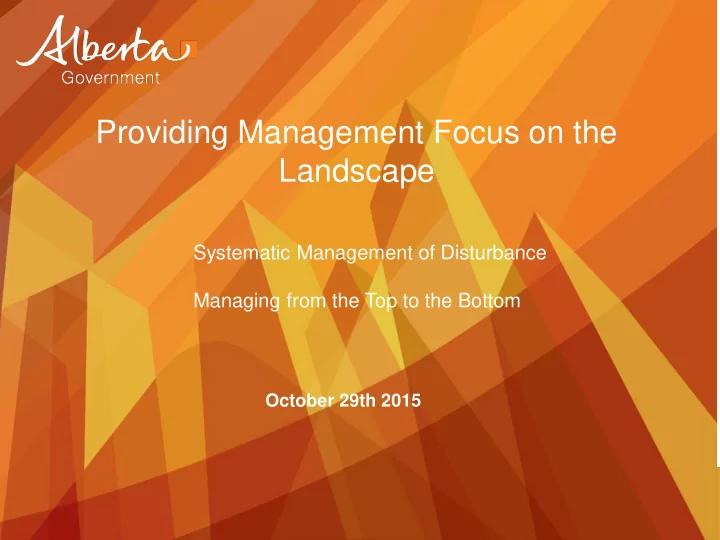

Providing Management Focus on the Landscape Systematic Management of Disturbance Managing from the Top to the Bottom October 29th 2015
Systematic management of Disturbances An Informed-Focused Approach to Managing Disturbance Tactical Plans Operational Plans Strategic Plans Site Level Landscape Level Marxan Optimization Management Landscape Prioritization Site Level Prioritization Priorities Landscape Management Plan ILM and Restoration Plans Established SAOS Regional Plan LARP Specific disturbances? Location on the BMF landscape? Toolkit ILM and restoration? Composition? Management Zones Management Areas
The Focused Management Approach Landscape Focus Getting to the Right Ball Park on the Landscape Where should we do management? What should we do for management? Where should we start?
Using Marxan to support the LMP and the BMF Objective : Identify Priority Areas for Footprint Management - Help to inform “zones” of management - Highlight key areas to support biodiversity (BMF)
a. b. c. d. Everything must be Planning spatially-explicit ‘Scenarios’ Units developed to: • Vary cost/constraint • Vary targets - Features features Cost Targets Optimized solution
Marxan Parameters • Study area for analysis – LAR and Moose Lake • Planning units – Quarter-sections (65 ha) – Total of 150, 126 units • Features selected based on: – BMF Indicators – Previous engagement – Regional input
Planning Units for Evaluating Management Options Planning The puzzle pieces Units Study area = 72,554 km 2 Planning units = 101,101 (¼ sections) Summarize information within ¼ sections Target areas for biodiversity priorities and management (Triage approach) Photo credit: Tim Vinge ¼ section is ~800 x 800 m (~66 ha)
Linkages to BMF • Not all BMF Tier 1,2,3 indicators can be included directly in the Marxan analysis • Indicators will also be considered indirectly through the inclusion of a constraint layer that captures existing footprint: – Interior habitat – Native terrestrial habitat – Native aquatic habitat • Indicators will benefit from the reduction of footprint though the LMP (e.g. non-native vascular plants, lotic connectivity) – BMF indicator methodology is still under development and can be incorporated at such a time when spatial layers are available
Marxan Parameters- Habitats • Features Included – Fen (BMF Tier 2) – Old Forest (BMF Tier 2) – Climate Change refugia • Vascular plants • Boreal birds – Wetland types (rich and poor fen, swamp, bog and open water) – Key wildlife and Biodiversity zones (AEP) – Special Access areas (AEP) – Ecologically significant areas (ESA analysis)
Marxan Parameters- Species • Features Included – Arctic Grayling (BMF Tier 2) – Caribou (BMF Tier 3) – Moose (BMF Tier 3) – Forest Birds Photo: Josh Laymon • Black-throated Green Warbler • Brown creeper Pileated • Raven • woodpecker Ovenbird • Pileated woodpecker habitat • Pine siskin • Red-breasted nuthatch • Ruby-crowned kinglet • Warbling vireo • White-throated sparrow • Yellow-bellied sapsucker Modelled by ABMI
Marxan Parameters- Species cont’d – Colonial nesting birds – Piping plover – Sharp-tailed grouse – Fisher/marten Pin cherry habitat – Wood bison – Wolf – S1 and S2 plants (rare) – Fruiting shrubs • Saskatoon • Beaked hazelnut • Pin cherry • Chokecherry • Buffaloberry • Blueberry • High-bush cranberry Modelled by Scott Nielsen, UofA
Setting Targets in Marxan Targets Please Select Items from the Menu Feature Target - Ovenbird 20% - Pine siskin 30% - Caribou 60% - Moose 50% - Marten 30% - Fisher 40% - Lynx 20% -Wolf 30% -Cultural sites - Look at the features as a list of items on a menu. We can select the priority values from the menu. Everyone’s priorities may be different both in terms of the type of value/feature and the level of the feature or target.
Cost- Development constraints • Marxan incorporates constraints on the landscape through a spatial cost layer – An index combining the bitumen pay thickness and existing footprint represents constraints to biodiversity • Identifying areas outside of human conflict, where possible, can increase probability of successful reclamation and create larger contiguous areas of habitat
Scenarios • 2 initial scenarios – Biodiversity features only- no cost – Biodiversity features with development cost • Targets consistent • Additional preliminary scenario to change extent – Force Marxan to seek solutions in high conflict areas
Results- 1. Biodiversity Only Scenario Biodiversity not evenly distributed
Results- 2. Development Constraints Scenario
Results- Comparing scenarios • Similar patterns, but: – Stronger selection to the periphery with economic constraint – Areas become more distinct • Fewer options with higher cost • Gypsy-Gordon and Dillon highlighted • Athabasca river corridor is distinct – Stony Mountain prominent without cost layer – Marguerite River and Birch Mountains areas consistently selected Economic constraint Biodiversity only
Changing the extent- opportunities within constrained areas • Lock out planning to get Marxan to achieve targets within a smaller extent • Can highlight areas to focus restoration or offsets preliminary
Supplementing the LMP • Priority areas that occur in relatively pristine areas can be primarily managed to minimize new footprint • Priority area that occur in areas with high existing footprint can be primarily managed for reclamation Seismic lines and restoration
The Focused Management Approach Site Level Focus Playing the Ball Game in the Right Park Which disturbances have a priority? Which treatments should we use? How long until restoration is achieved? DART Disturbance and Recovery Trajectories Scott Nielsen and Cassidy Van Rensen University of Alberta
Restoration priorities based on Phase 1 feature data and the Restoration Prioritization Matrix
Recommend
More recommend